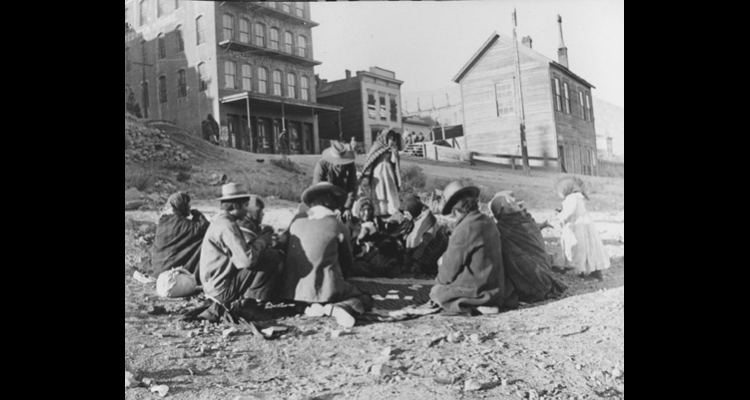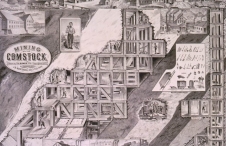Native Americans on the Comstock
The development of the Comstock took a toll on the Northern Paiute Native American population of the region, but they adapted and even prospered in ways which seemed unlikely. Prior to contact with Euro-Americans, the Native American population of the Great Basin was well adapted to the fragile, arid environment, living in seasonally mobile bands and coming together for collective hunts or harvests. When trappers, travelers, and settlers began moving into the Great Basin in the 1840s, Native Americans had to adapt to the changing culture and environment.
The influx of non-Native inhabitants put pressure on scarce resources, which culminated with the discovery of the Comstock Lode in 1859. Thousands of new arrivals precipitated a crisis, and friction between the new settlers and Native Americans resulted in the Pyramid Lake War in 1860. Although the Northern Paiutes and their Bannock and Shoshone allies proved the masters of military strategy, Euro-Americans eventually emerged victorious largely through numerical superiority. Perhaps because the conflict was so brief, Euro-American residents of the Comstock felt little residual hostility towards the Northern Paiutes, and they were accepted in the newly settled environment.
Archaeologist Eugene M. Hattori's research examines Native Americans' adaptations to the new environment of the Comstock. Hattori concludes that the flexibility developed over thousands of years of climate and resource changes enabled the Northern Paiutes to adapt. Clearly, damaged food reserves, the introduction of new diseases, racism, and alcoholism took a terrible toll on the indigenous population. Hattori notes, however, that after an initial population decline, there was growth and limited prosperity.
For example, some native peoples worked for wages, joining other inhabitants of the Comstock in service jobs. Beginning in the late 1850s, Henry Comstock employed several to help him excavate his claim. During the following decades, their work in the district consisted of common labor, laundering, house cleaning, and other similar activities. Additionally, Northern Paiutes adapted their foraging skills and took advantage of the wasteful practices of many Comstock residents by scavenging for food and supplies.
Northern Paiutes usually preferred to live on the outskirts of Virginia City rather than in the town. Historical photographs show their houses at the base of mine dumps close to discarded materials. Traditional forms of architecture were often supplemented by collected items; for example, kerosene cans were cut into sheets for roofing. Contemporary accounts describe seasonal gatherings on the outskirts of town, an echo of pre-contact traditions. Thus the Northern Paiutes were able to integrate into the local culture and maintain their own traditions.
Evidence of Native American acculturation and integration includes examples of Northern Paiutes speaking English and occasionally accepting Christian baptism. Native American activist Sarah Winnemucca, the daughter of Chief Winnemucca, frequented the Comstock from its earliest days, and one account places her in a quadrille at a dance. Additionally, the conclusion of the Fourth of July Parade usually featured Native Americans dressed in feathers, paint, and traditional clothing, re-enacting a battle charge from the Pyramid Lake War, with historical accuracy set aside.
Nonetheless, accounts of racism and hostility directed at local Northern Paiutes are plentiful. Antagonism between the diverse groups was predictable; one of the more strained relationships occurred between Native Americans and Chinese immigrants. Some blamed the Northern Paiute practice of eating the remains of funerary feasts left by the Chinese to honor the newly departed, but competition for employment was another likely source of conflict.
Despite the loss of land and traditional sources of food, compounded by disease and racism, Northern Paiutes demonstrated strength, tenacity, and dignity by adapting and maintaining their traditional way of life.




